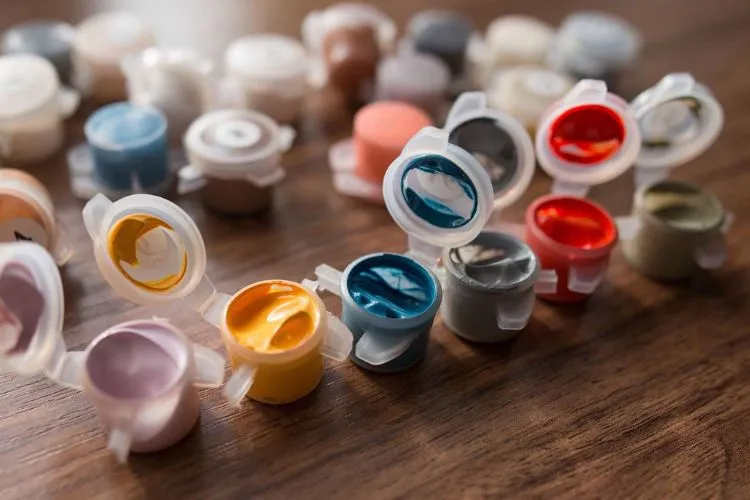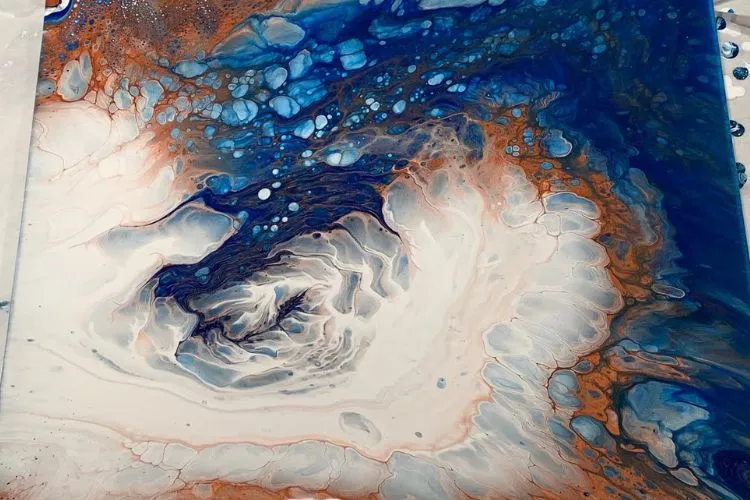When it comes to the world of paints and finishes, the question of whether you can paint enamel over acrylic is a common one. Both enamel and acrylic paints have their unique properties, uses, and fans. So, can you paint enamel over acrylic?
This guide dives deep into the dos and don’ts, the hows, and the whys of painting enamel over acrylic, ensuring a smooth and enduring finish for your projects.

Understanding Paint Types
Before we delve into the specifics of layering paints, let’s first understand what we’re working with.
Acrylic Paint
Acrylic paint is a water-based paint known for its quick drying time and versatility. Its wide usage in arts, crafts, and home DIY projects stems from its easiness to clean up and its adaptability to different surfaces.
Acrylic paint adheres well to most bases without the need for a primer, making it a popular choice for both beginners and professionals.
Enamel Paint
On the other hand, enamel paint often refers to oil-based paints, but there are water-based versions as well. Enamel stands out for its durability, providing a hard, glossy finish that’s resistant to the elements.
This type of paint is ideal for surfaces that endure a lot of wear and tear, making it common for trim, doors, and outdoor projects.
The main differences between acrylic and enamel paint lie in their composition, drying times, and the finish they provide. It’s important to understand these aspects as they directly influence the outcome when applying enamel over acrylic.
Can You Paint Enamel Over Acrylic?
So, can you paint enamel over acrylic? Yes, but with some important caveats.
Preliminary Considerations
The success of painting enamel over acrylic starts with surface preparation. Ensuring the surface is clean, dry, and slightly rough helps the new paint layer adhere better. Without proper prep, you risk the paint peeling off over time.
Primer: Is It Necessary?
While acrylic paint usually bonds well without a primer, adding a layer under enamel paint can provide extra durability and adhesion.
Using a primer is especially recommended when dealing with higher gloss acrylics or when the surface will be exposed to harsh conditions.
Step-by-Step Guide to Painting Enamel Over Acrylic

Supplies and Tools Needed
Gather your enamel paint, brushes or rollers, primer (if using), sandpaper, and cleaning supplies before starting your project. Having everything at hand simplifies the process.
Preparing the Acrylic Surface
Begin with ensuring the acrylic paint is completely dry. Clean the surface to remove any oils or dust.
Lightly sanding the acrylic paint with fine-grit sandpaper creates a texture that helps the next layer grip better. If you decide to use a primer, apply it according to the manufacturer’s instructions.
Applying Enamel Paint
When applying enamel paint, especially if it’s oil-based, keep your strokes even and work in a well-ventilated area.
Whether you’re using a brush or a spray, aim for thin coats to prevent drips and ensure a smooth finish. Be patient with drying times; enamel paint often takes longer to dry compared to acrylic.
Tips for Success
Here are some tips to ensure a flawless finish.
Do’s and Don’ts
Do clean and sand the surface thoroughly. Don’t rush between coats; always allow for adequate drying time. Do use thin coats for a smoother finish.
Pro Tips
Achieving a professional-quality finish involves patience and attention to detail. Testing the paint on a small area first can help you get a feel for the final look and allow you to make adjustments as needed.
Troubleshooting Common Problems

Adhesion Issues
Paint not sticking? Make sure the surface was clean and properly sanded. Applying a suitable primer can also help improve adhesion.
Bubbling and Cracking
These issues often result from painting over an unprepared surface or applying thick coats. Thin, even layers are key to avoiding these common problems.
Fixing Mistakes
If you make a mistake, don’t panic. Sanding the problematic area lightly and reapplying paint can often fix the issue without starting over from scratch.
You may also read: Can You Mix Acrylic and Latex Paint?
Preservation and Maintenance
Ensuring Longevity
A clear sealant or topcoat over your enamel paint can protect it from scratches and UV rays, extending the life of your project.
Cleaning and Care
Treat painted surfaces with care. Gentle cleaning with a soft cloth and mild detergent will keep them looking fresh without damaging the paint.
Health and Safety Precautions

Understanding Ventilation Needs
Working with paints, especially oil-based enamels, requires good airflow due to fumes that can be harmful if inhaled in enclosed spaces.
Ensuring proper ventilation is critical for safety and comfort, and it also aids in the curing process of the paint.
Personal Protective Equipment (PPE)
When painting, it’s vital to protect your skin, eyes, and respiratory system from irritants and chemicals. Gloves prevent skin contact with paint and solvents, while masks, preferably with a filter suitable for organic vapors, shield against inhalation of fumes.
Safety goggles are essential to protect the eyes from splashes. Using the right PPE is necessary for a safe painting experience.
Frequently Asked Questions (FAQs)
How long should acrylic paint dry before applying enamel?
It’s best to wait at least 24 hours to ensure the acrylic paint is thoroughly dry before applying enamel.
Can water-based enamel paint be applied over acrylic paint?
Yes, water-based enamel can be applied over acrylic paint, often with easier cleanup and shorter drying times compared to oil-based enamel.
Is it necessary to sand between coats of paint when painting enamel over acrylic?
Light sanding between coats can help improve adhesion, especially if you’re dealing with glossy surfaces or applying multiple layers.
How can I avoid brush marks when applying enamel over acrylic?
Use high-quality brushes, apply thin coats, and consider using a paint conditioner to improve flow and level the paint.
Can I apply clear enamel over acrylic for a glossy finish?
Yes, applying a clear enamel topcoat can enhance the durability of your acrylic paint and provide a glossy finish. Ensure the acrylic paint is fully dry before applying.
Conclusion:
Painting enamel over acrylic is possible and can result in a beautiful, durable finish when done correctly. The key lies in preparation and patience, allowing each layer to properly adhere and dry.
With the right approach, your painted projects will not only look great but also stand the test of time.

Meet Isabella Anderson, your acrylic painting mentor with over a decade of brush-wielding mastery. Dive into the colorful world of acrylics with her expert guidance, featured exclusively on ‘Acrylic Authority.’ Unleash your inner artist and explore the limitless possibilities of this versatile medium alongside a true acrylic aficionado.
